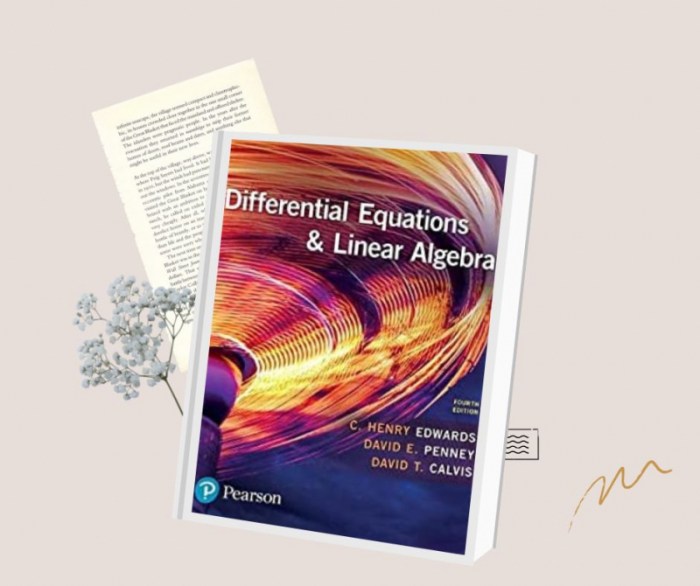Differential equations and linear algebra 4th edition solutions – Embark on an enlightening journey with Differential Equations and Linear Algebra, 4th Edition, a comprehensive guide that unlocks the mysteries of these fundamental mathematical concepts. Delving into the intricacies of differential equations and linear algebra, this definitive resource empowers readers with a deep understanding of their applications across diverse fields.
From unraveling the complexities of engineering problems to deciphering the dynamics of physical systems, differential equations and linear algebra play a pivotal role in shaping our understanding of the world. This fourth edition seamlessly blends theoretical foundations with practical insights, equipping readers with the tools they need to tackle real-world challenges with confidence.
1. Introduction to Differential Equations and Linear Algebra
Differential equations and linear algebra are two fundamental branches of mathematics that play a crucial role in various fields of science and engineering. Differential equations describe the rate of change of a system over time, while linear algebra deals with the study of vectors, matrices, and linear transformations.
Applications of differential equations and linear algebra are found in a wide range of disciplines, including physics, engineering, economics, and biology. For instance, differential equations are used to model the motion of objects, the flow of fluids, and the growth of populations, while linear algebra is essential for solving systems of equations, analyzing data, and designing computer graphics.
The historical development of differential equations and linear algebra spans several centuries. The concept of differential equations can be traced back to the 17th century with the work of Isaac Newton and Gottfried Leibniz, while linear algebra emerged as a distinct field in the 19th century with the contributions of mathematicians such as Carl Friedrich Gauss and William Rowan Hamilton.
2. Systems of Differential Equations
A system of differential equations consists of two or more differential equations that are linked together. Systems of differential equations arise in many applications, such as modeling the dynamics of physical systems, chemical reactions, and population growth.
There are various methods for solving systems of differential equations, including analytical methods, numerical methods, and graphical methods. The choice of method depends on the complexity of the system and the desired level of accuracy.
3. Matrix Theory
A matrix is a rectangular array of numbers arranged in rows and columns. Matrices are used to represent systems of linear equations, transformations, and other mathematical operations.
The operations on matrices include addition, subtraction, multiplication, and inversion. These operations allow matrices to be used for solving systems of equations, finding eigenvalues and eigenvectors, and performing other mathematical calculations.
4. Vector Spaces
A vector space is a set of vectors that can be added together and multiplied by scalars. Vector spaces are used to represent physical quantities such as forces, velocities, and positions, as well as abstract mathematical concepts such as functions and probability distributions.
The properties of vector spaces include linearity, closure under addition and scalar multiplication, and the existence of a zero vector and an additive inverse for each vector.
5. Eigenvalues and Eigenvectors: Differential Equations And Linear Algebra 4th Edition Solutions

An eigenvalue is a scalar that, when multiplied by a vector, produces a multiple of the same vector. An eigenvector is a vector that is multiplied by a scalar to produce itself.
Eigenvalues and eigenvectors are used in various applications, such as solving systems of differential equations, analyzing vibrations, and finding principal components in data analysis.
6. Applications of Differential Equations and Linear Algebra
Differential equations and linear algebra have numerous applications in engineering, physics, and other fields.
- In engineering, differential equations are used to model the behavior of mechanical systems, electrical circuits, and fluid flow.
- In physics, differential equations are used to describe the motion of objects, the propagation of waves, and the behavior of quantum systems.
- In economics, differential equations are used to model the dynamics of markets, the growth of economies, and the behavior of financial systems.
- In biology, differential equations are used to model the growth of populations, the spread of diseases, and the dynamics of ecosystems.
The role of differential equations and linear algebra in modeling and solving real-world problems is crucial. These mathematical tools provide a powerful framework for understanding and predicting the behavior of complex systems in various fields.
General Inquiries
What is the significance of differential equations and linear algebra in engineering?
Differential equations and linear algebra are essential tools for modeling and analyzing complex systems in engineering, such as electrical circuits, mechanical vibrations, and fluid dynamics. They enable engineers to predict the behavior of these systems and design solutions that meet specific performance requirements.
How does linear algebra relate to differential equations?
Linear algebra provides a framework for understanding the behavior of systems of differential equations. Matrices and vector spaces, key concepts in linear algebra, allow for the representation and analysis of differential equations in a systematic and efficient manner.
What are the key applications of differential equations and linear algebra in physics?
Differential equations and linear algebra are widely used in physics to describe and predict the behavior of physical systems. They are essential for modeling phenomena such as wave propagation, heat transfer, and quantum mechanics.
